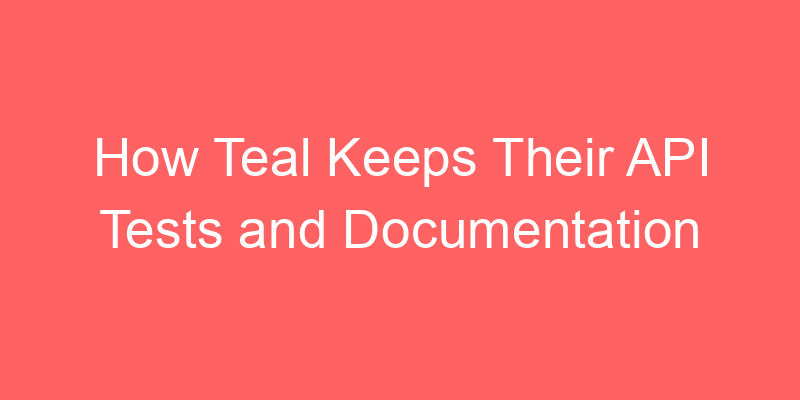Teal Keeps Their API Tests and Documentation in Sync
Understanding the Importance of Synchronized API Tests and Documentation
In the world of modern software development, ensuring that API tests and documentation remain in sync is crucial for seamless integration and collaboration. When tests and documentation align perfectly, developers, testers, and stakeholders can work more efficiently and effectively.
Challenges Faced in Keeping API Tests and Documentation Updated
One of the primary challenges faced by teams is the divergence between API tests and their corresponding documentation over time. As APIs evolve with new features and updates, it becomes increasingly difficult to maintain accurate documentation that reflects these changes.
For example, imagine a scenario where a software team releases an updated version of an API with enhanced security features. If the API documentation isn’t promptly updated to reflect these changes, developers relying on outdated documentation might struggle to implement the new security protocols correctly.
Best Practices for Keeping API Tests and Documentation in Sync
To address these challenges effectively, teams can adopt several best practices:
- Automated Testing and Documentation Tools: Utilize automated tools that generate documentation directly from API tests. This ensures that any changes made in the tests are immediately reflected in the documentation.
- Version Control: Maintain version control for both API tests and documentation. By using versioning systems such as Git, teams can track changes over time and revert to previous versions if necessary.
- Collaborative Workflows: Foster collaboration between developers, testers, and technical writers. Encourage regular meetings and checkpoints to review both the tests and documentation.
- Documentation as Code: Treat documentation as part of the codebase. By integrating documentation updates into the regular development workflow, teams can ensure that it receives the same level of attention as the code itself.
Real-World Example: Maintaining Sync Between API Tests and Documentation
Consider a software company developing a RESTful API for a new e-commerce platform. The development team uses Swagger for API documentation and integrates it with their continuous integration/continuous deployment (CI/CD) pipeline.
During the development phase, each API endpoint is thoroughly tested using automated test scripts. These tests not only validate the functionality but also serve as living documentation of the API’s expected behavior.
When the team releases a new version of the API, the CI/CD pipeline automatically updates the Swagger documentation based on the latest test results. This ensures that the documentation always reflects the current state of the API, including any new endpoints or parameters.
Conclusion
Keeping API tests and documentation in sync is not just a matter of convenience; it’s a critical practice that enhances overall software quality and developer productivity. By implementing automated tools, version control, collaborative workflows, and treating documentation as code, teams can effectively manage the complexity of modern APIs and ensure that all stakeholders have access to accurate and up-to-date information.
For any software development team looking to streamline their processes and improve documentation accuracy, prioritizing synchronization between API tests and documentation is key.
How Teal Keeps Their API Tests and Documentation in Sync
Career Advice and Tips
In today’s competitive job market, staying ahead requires more than just technical skills. It demands a deep understanding of how to integrate and synchronize critical elements like API tests and documentation effectively. For aspiring professionals in software development and quality assurance roles, mastering this synchronization can significantly enhance career prospects.
Successful integration of API tests and documentation not only ensures seamless software development cycles but also highlights a candidate’s proficiency in maintaining robust and reliable applications. Here’s how you can leverage this skill to advance your career in tech.
Provide 10 Similar Jobs Related to Main Topic in Table Format with Description
| Job Title | Description |
|---|---|
| API Integration Specialist | Responsible for integrating APIs across platforms and ensuring seamless communication. |
| Technical Writer | Creates detailed API documentation and user guides for developers and end-users. |
| Quality Assurance Engineer | Develops and executes API tests to ensure software reliability and performance. |
| Software Developer | Works on developing APIs and integrating them into larger software systems. |
Resume FAQs About the Topic
How should I highlight API testing and documentation skills on my resume?
Emphasize specific tools and methodologies you’ve used, such as Swagger for documentation or Postman for testing. Quantify your impact, such as reducing bugs or improving documentation accessibility.
What are the essential skills employers look for in candidates related to API synchronization?
Proficiency in testing frameworks, technical writing abilities, version control systems like Git, and understanding of RESTful APIs are crucial.
Resume Checklist About the Topic
- Include a dedicated section highlighting your experience with API testing and documentation.
- Showcase specific projects where you successfully synchronized API tests and documentation.
- Quantify your achievements, such as reducing deployment time or improving API usability.
- Use action verbs like ‘implemented,’ ‘automated,’ and ‘optimized’ to describe your contributions.
Conclusion
Mastering the synchronization of API tests and documentation is not just about technical expertise; it’s about demonstrating your ability to streamline processes and enhance software reliability. By integrating these skills into your career strategy and resume, you can stand out in competitive job markets and open doors to new opportunities in software development and quality assurance.
`
Generate Your NEXT Resume with AI
Accelerate your resume crafting with the AI Resume Builder. Create personalized resume summaries in seconds.




